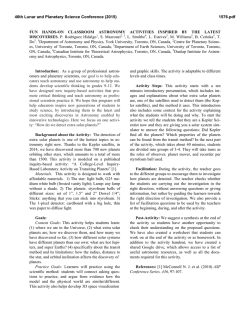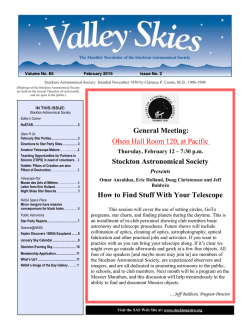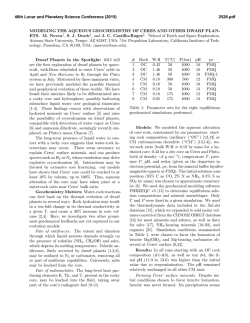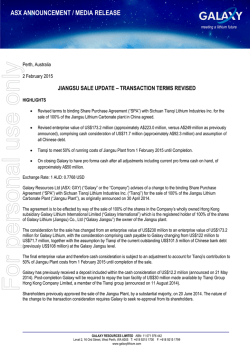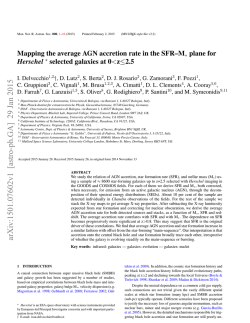
NASA spacecraft New Horizons nears final leg of historic nine year
Volume 52 No. 02 February 1, 2015 NEXT MEETING 7:30 p.m., Monday, February 2, 2015 Maturango Museum, 100 East Las Flores Avenue, Ridgecrest, California. PROGRAM FOR THE FEBURARY 2nd, MEETING - Scott Cameron will be giving us a talk about the Kuiper Belt. Scott Cameron is the astronomy professor at Cerro Coso Community Collage (CCCC) Ridgecrest campus, director of the Shlanta Observatory and a member of CLAS. 2015 Calendars and handbooks are available. Dues for 2015, if not already paid, are due now. DATES TO KEEP IN MIND Monday, Feb. 02: Regular CLAS Meeting at the Maturango Museum in Ridgecrest, 7:30 p.m. Friday, Feb. 20: No star party – No problem !! Watch Lovejoy in real time from Israel http://www.bareket-astro.com/live-astronomical-web-cast/lovejoy-and-asteroid-2004bl-webcasts.html Friday, Feb. 20: Deadline for next Skywatchers Newsletter. Monday, Mar. 02: Regular CLAS Meeting at the Maturango Museum in Ridgecrest, 7:30 p.m. STAR PARTY SCHEDULE FOR THE 2015 SEASON: Star Parties will be held on the dates listed below. Star Parties are an activity where members and guests come together to view the skies. If you have a telescope, bring it; if not, come and look through someone else’s. They are held at a site in the open desert south of Ridgecrest. To reach the site from Ridgecrest, go south on China Lake Boulevard 6.5 miles from its intersection with Ridgecrest Boulevard. Continue straight across Highway 395 and you will be on Brown Road (Old Highway 395). Follow Brown Road as it curves to the right and goes west. After 2.3 miles, there will be a 30-inch orange cone on the left. Turn left and follow the dirt road marked by 12-inch cones. The CLAS star party is 0.5 miles along this road. Signs and cones will be put out about a half hour before viewing starts. Call Roger Brower 760-375-1181 or Bruce Churchill 760-677-1143, for more information. There are no Star Parties scheduled for the month of February. We will resume our monthly events in March 2015. If something else comes up - watch your email. Some public star parties are held at the Maturango Museum “Carroll L. Evans, Jr. Observatory Dome” on the Thursday evening proceeding some Brown Road Friday Star Parties. Exact dates will be announced by email. NASA spacecraft New Horizons nears final leg of historic nine year mission to Pluto A Nasa probe which has travelled more than three billion miles on a nine-year journey is to begin sending back pictures of mysterious and icy Pluto today. The New Horizons spacecraft is still more than 100 million miles from Pluto, with the first pictures expected to show little more than bright dots, but the photos will help keep the probe on track for a flypast in July. "New Horizons has been a mission of delayed gratification in many respects, and it's finally happening now," project scientist Hal Weaver of Johns Hopkins University's Applied Physics Laboratory told AFP. "It's going to be a sprint for the next seven months, basically, to the finish line," he said Friday. "We can't wait to turn Pluto into a real world, instead of just a little pixelated blob." Credit: NASA/JHU APL/SwRI/Steve Gribben New Horizons awoke from a hibernation period in early December, and scientists have spent weeks preparing it for the final approach to Pluto, which is 4.67 billion miles from Earth. When New Horizons, which is the size of a small grand piano, nears Pluto it will be travelling so fast that it will not be able to enter into the planet's orbit, but will hurtle past it. With recording instruments functioning at different distances, Nasa needs to chart the craft's route with exactitude in order to gather all of the data. The craft's closest approach to the planet is scheduled for 14 July at 11.50 GMT, when New Horizons will pass Pluto roughly 7,700 miles from the surface. It is classified now as a 'dwarf planet', and will be the first time probes have come so close to the 2,300 km wide ice covered rock. Andy Cheng, the principal investigator on the probe's main camera, which is called LORRI, told the BBC that the images taken by New Horizons could offer vital insights into dwarf planets, which are the most numerous planetary class in the solar system. "The most recent surprise we had was with the Rosetta mission. Hubble had made a 'shape model' of Comet 67P but no-one expected it to look like a rubber duckie," he told BBC News. "I am more than hopeful that we will get similar surprises with New Horizons - it's what we should expect." After the flypast, New Horizon is scheduled to travel to the Kuiper Belt, an icy region beyond the main planets of the solar system, which some believe may contain thousands of Pluto like entities. Source: http://www.ibtimes.co.uk/nasa-spacecraft-new-horizons-nears-final-leg-historic-nine-year-mission-pluto-1485052 Where is “New Horizons” (real time updates): http://pluto.jhuapl.edu/mission/whereis_nh.php Alien Life? Nah, But Myserious White Spot on Ceres Leaves NASA Scientists Flummoxed A series of new photos taken by NASA's Dawn spacecraft of the dwarf planet Ceres on Jan. 13 reveals a strange and flickering white blotch on the extraterrestrial world that has baffled scientists. Dawn, which was launched in 2007 to study the two largest objects in the asteroid belt, Vesta and Ceres, has captured photos revealing a white spot on Ceres as the space probe rapidly approached the dwarf planet. Scientists involved with the Dawn mission, however, did not indicate what this mysterious dot is when Dawn's new photos of Ceres were released on Jan. 19. Dawn mission director Marc Rayman acknowledged that there is something on the dwarf planet that reflects more light but said that what this is still remains a mystery. Dawn has captured images that show light and dark areas on the face of the planet indicating surface features such as craters but none of the specific features including the mysterious white dot can yet be resolved. NASA's Hubble Space Telescope has taken images of Ceres in 2003 and 2004, and the white spot also showed up in these images. While scientists are not yet certain what this is, the best hypothesis they currently have is that the distinct blotch is a frozen pool of water at a crater's bottom that was clear enough to reflect sunlight. Scientists are interested in studying Ceres because it is a unique and special object in the solar system. Having an average diameter of 590 miles, or about the size of Texas, it is the largest body in the main asteroid belt. Ceres is likewise simultaneously classified as an asteroid and a dwarf planet. As a dwarf planet, Ceres is the smallest in our solar system. Researchers believe that this extraterrestrial world has large amounts of ice and that there is a possibility that its surface hides an ocean. The Dawn spacecraft is anticipated to unveil more of the mysteries of this dwarf planet as it is set to enter Ceres' orbit by March later this year. The $466 million spacecraft has earlier made a year-long pit stop at Vesta in the summer of 2011. Vesta is the second largest object that exists in the asteroid belt. "The team is very excited to examine the surface of Ceres in never-before-seen detail," said Dawn mission principal investigator Chris Russell. "We look forward to the surprises this mysterious world may bring." Link: http://www.techtimes.com/articles/28591/20150125/alien-life-nah-but-myserious-white-spot-on-ceres-leaves-nasa-scientistsflummoxed.htm Video link: http://d1jqu7g1y74ds1.cloudfront.net/wp-content/uploads/2015/01/pia19168.gif Three nearly Earth-size planets found orbiting nearby star: One in 'Goldilocks' zone A multinational, multi-institution team of researchers led by University of Arizona scientist Ian Crossfield has found a star with three planets, one of which may have temperatures moderate enough for liquid water -- and maybe even life -- to exist. NASA's Kepler Space Telescope, despite being hobbled by the loss of critical guidance systems, has discovered a star with three planets only slightly larger than Earth. The outermost planet orbits in the "Goldilocks" zone, a region where surface temperatures could be moderate enough for liquid water and perhaps life, to exist. Credit: NASA The star, EPIC 201367065, is a cool red M-dwarf about half the size and mass of our own sun. At a distance of 150 light years, the star ranks among the top 10 nearest stars known to have transiting planets. The star's proximity means it's bright enough for astronomers to study the planets' atmospheres to determine whether they are like Earth's atmosphere and possibly conducive to life. "A thin atmosphere made of nitrogen and oxygen has allowed life to thrive on Earth. But nature is full of surprises. Many exoplanets discovered by the Kepler mission are enveloped by thick, hydrogen-rich atmospheres that are probably incompatible with life as we know it," said Ian Crossfield, the University of Arizona astronomer who led the study. A paper describing the find by astronomers at the University of Arizona, the University of California, Berkeley, the University of Hawaii, Manoa, and other institutions has been submitted to Astrophysical Journal and is freely available on the arXiv website . NASA and the National Science Foundation funded the research. Co-authors of the paper include Joshua Schlieder of NASA Ames Research Center and colleagues from Germany, the United Kingdom and the U.S. The three planets are 2.1, 1.7 and 1.5 times the size of Earth. The smallest and outermost planet, at 1.5 Earth radii, orbits far enough from its host star that it receives levels of light from its star similar to those received by Earth from the sun, said UC Berkeley graduate student Erik Petigura. He discovered the planets Jan. 6 while conducting a computer analysis of the Kepler data NASA has made available to astronomers. In order from farthest to closest to their star, the three planets receive 10.5, 3.2 and 1.4 times the light intensity of Earth, Petigura calculated. "Most planets we have found to date are scorched. This system is the closest star with lukewarm transiting planets," Petigura said. "There is a very real possibility that the outermost planet is rocky like Earth, which means this planet could have the right temperature to support liquid water oceans." University of Hawaii astronomer Andrew Howard noted that extrasolar planets are discovered by the hundreds these days, though many astronomers are left wondering if any of the newfound worlds are really like Earth. The newly discovered planetary system will help resolve this question, he said. "We've learned in the past year that planets the size and temperature of Earth are common in our Milky Way galaxy," Howard said. "We also discovered some Earth-size planets that appear to be made of the same materials as our Earth, mostly rock and iron." Kepler's K2 mission After Petigura found the planets in the Kepler light curves, the team quickly employed telescopes in Chile, Hawaii and California to characterize the star's mass, radius, temperature and age. Two of the telescopes involved, the Automated Planet Finder on Mount Hamilton near San Jose, California, and the Keck Telescope on Mauna Kea, Hawaii, are University of California facilities. The next step will be observations with other telescopes, including the Hubble Space Telescope, to take the spectroscopic fingerprint of the molecules in the planetary atmospheres. If these warm, nearly Earth-size planets have puffy, hydrogen-rich atmospheres, Hubble will see the telltale signal, Petigura said. The discovery is all the more remarkable, he said, because the Kepler telescope lost two reaction wheels that kept it pointing at a fixed spot in space. Kepler was reborn in 2014 as 'K2' with a clever strategy of pointing the telescope in the plane of Earth's orbit, the ecliptic, to stabilize the spacecraft. Kepler is now back to mining the cosmos for planets by searching for eclipses or "transits," as planets pass in front of their host stars and periodically block some of the starlight. "This discovery proves that K2, despite being somewhat compromised, can still find exciting and scientifically compelling planets," Petigura said. "This ingenious new use of Kepler is a testament to the ingenuity of the scientists and engineers at NASA. This discovery shows that Kepler can still do great science." Kepler sees only a small fraction of the planetary systems in its gaze: only those with orbital planes aligned edge-on to our view from Earth. Planets with large orbital tilts are missed by Kepler. A census of Kepler planets the team conducted in 2013 corrected statistically for these random orbital orientations and concluded that one in five sun-like stars in the Milky Way Galaxy have Earth-size planets in the habitable zone. Accounting for other types of stars as well, there may be 40 billion such planets galaxy wide. The original Kepler mission found thousands of small planets, but most of them were too faint and far away to assess their density and composition and thus determine whether they were high-density, rocky planets like Earth or puffy, low-density planets like Uranus and Neptune. Because the star EPIC-201 is nearby, these mass measurements are possible. The host star, an M-dwarf, is less intrinsically bright than the sun, which means that its planets can reside close to the host-star and still enjoy lukewarm temperatures. According to Howard, the system most like that of EPIC-201 is Kepler-138, an M-dwarf star with three planets of similar size, though none are in the habitable zone. Source: http://newscenter.berkeley.edu/2015/01/16/three-nearly-earth-size-planets-found-orbiting-nearby-star/ Paper: http://arxiv.org/abs/1501.03798 Hubble Finds Extremely Distant Galaxy through Cosmic Magnifying Glass Peering through a giant cosmic magnifying glass, NASA's Hubble Space Telescope has spotted one of the farthest, faintest, and smallest galaxies ever seen. The diminutive object is estimated to be over 13 billion light-years away. This new detection is considered one of the most reliable distance measurements of a galaxy that existed in the early universe, said the Hubble researchers. They used two independent methods to estimate its distance. Credit: http://hubblesite.org/newscenter/archive/releases/2014/39/image/a/ The galaxy appears as a tiny blob that is only a small fraction of the size of our Milky Way galaxy. But it offers a peek back into a time when the universe was only about 500 million years old, roughly 3 percent of its current age of 13.7 billion years. Astronomers have uncovered about 10 other galaxy candidates at this early era. But this newly found galaxy is significantly smaller and fainter than most of those other remote objects detected to date. "This object is a unique example of what is suspected to be an abundant, underlying population of extremely small and faint galaxies at about 500 million years after the big bang," explained study leader Adi Zitrin of the California Institute of Technology in Pasadena. "The discovery is telling us that galaxies as faint as this one exist, and we should continue looking for them and even fainter objects so that we can understand how galaxies and the universe have evolved over time." The galaxy was detected as part of the Frontier Fields program, an ambitious three-year effort, begun in 2013, that teams Hubble with NASA's other Great Observatories — the Spitzer Space Telescope and the Chandra X-ray Observatory — to probe the early universe by studying large galaxy clusters. These clusters are so massive that their gravity deflects light passing through them, magnifying, brightening, and distorting background objects in a phenomenon called gravitational lensing. These powerful lenses allow astronomers to find many dim, distant structures that otherwise might be too faint to see. In this new discovery, the lensing power of the mammoth galaxy cluster Abell 2744, nicknamed Pandora's Cluster, produced three magnified images of the same galaxy. Each magnified image makes the galaxy appear as much as 10 times larger and brighter than it would look without the intervening lens. An analysis of the distant galaxy shows that it measures merely 850 light-years across, 500 times smaller than the Milky Way, and is estimated to have a mass of only 40 million suns. The galaxy's star formation rate is about one star every three years (one-third the star formation rate in the Milky Way). Although this may seem low, Zitrin said that given its small size and low mass, the tiny galaxy is in fact rapidly evolving and efficiently forming stars. "Galaxies such as this one are probably small clumps of matter that are starting to form stars and shine light, but they don't have a defined structure yet," Zitrin said. "Therefore, it's possible that we only see one bright clump magnified due to the lensing, and this is one possibility as to why it is smaller than typical field galaxies of that time." Zitrin's team spotted the galaxy's gravitationally multiplied images using near-infrared and visible-light photos of the galaxy cluster taken by Hubble's Wide Field Camera 3 and Advanced Camera for Surveys. But at first they didn't know how far away it was from Earth. Normally, astronomers use spectroscopy to determine an object's distance. The farther away a galaxy, the more its light has been stretched by the universe's expansion. Astronomers can precisely measure this effect through spectroscopy, which characterizes an object's light. But the gravitationally lensed galaxy and other objects found at this early epoch are too far away and too dim for astronomers to use spectroscopy. Astronomers instead analyze an object's color to estimate its distance. The universe's expansion reddens an object's color in predictable ways, which scientists can measure. Members of Zitrin's team not only performed the color-analysis technique, but they also took advantage of the multiple images produced by the gravitational lens to independently confirm their distance estimate. The astronomers measured the angular separation between the three magnified images of the galaxy in the Hubble photos. The greater the angular separation due to lensing, the farther away the object is from Earth. To test this concept, the astronomers compared the three magnified images with the locations of several other multiply imaged objects lensed by Abell 2744 that are not as far behind the cluster. The angular distance between the magnified images of the closer galaxies was smaller. "These measurements imply that, given the large angular separation between the three images of our background galaxy, the object must lie very far away," Zitrin explained. "It also matches the distance estimate we calculated, based on the color-analysis technique. So we are about 95 percent confident that this object is at a remote distance, at redshift 10 (a measure of the stretching of space since the big bang). The lensing takes away any doubt that this might be a heavily reddened, nearby object masquerading as a far more distant object." Astronomers have long debated whether such early galaxies could have provided enough radiation to warm the hydrogen that cooled soon after the big bang. This process, called "reionization," is thought to have occurred 200 million to 1 billion years after the birth of the universe. Reionization made the universe transparent to light, allowing astronomers to look far back into time without running into a "fog" of cold hydrogen. "We tend to assume that galaxies ionized the universe with their ultraviolet light," Zitrin said. "But we do not see enough galaxies or light that could do that. So we need to look at fainter and fainter galaxies, and the Frontier Fields and galaxy cluster lensing can help us achieve this goal." Link: http://hubblesite.org/newscenter/archive/releases/2014/39/full/ Newly Identified Galactic Supercluster Is Home to the Milky Way Astronomers using the National Science Foundation’s Green Bank Telescope (GBT) -- among other telescopes -- have determined that our own Milky Way galaxy is part of a newly identified ginormous supercluster of galaxies, which they have dubbed “Laniakea,” which means “immense heaven” in Hawaiian. This discovery clarifies the boundaries of our galactic neighborhood and establishes previously unrecognized linkages among various galaxy clusters in the local Universe. “We have finally established the contours that define the supercluster of galaxies we can call home,” said lead researcher R. Brent Tully, an astronomer at the University of Hawaii at Manoa. “This is not unlike finding out for the first time that your hometown is actually part of much larger country that borders other nations.” The paper explaining this work is the cover story of the September 4 issue of the journal Nature. Superclusters are among the largest structures in the known Universe. They are made up of groups, like our own Local Group, that contain dozens of galaxies, and massive clusters that contain hundreds of galaxies, all interconnected in a web of filaments. Though these structures are interconnected, they have poorly defined boundaries. To better refine cosmic mapmaking, the researchers are proposing a new way to evaluate these largescale galaxy structures by examining their impact on the motions of galaxies. A galaxy between structures will be caught in a gravitational tug-of-war in which the balance of the gravitational forces from the surrounding large-scale structures determines the galaxy’s motion. By using the GBT and other radio telescopes to map the velocities of galaxies throughout our local Universe, the team was able to define the region of space where each supercluster dominates. “Green Bank Telescope observations have played a significant role in the research leading to this new understanding of the limits and relationships among a number of superclusters,” said Tully. Link: https://public.nrao.edu/images/non-gallery/2014/c-blue/09-02-GBTSupercluster/GBTSupercluster2_nrao.jpg The Milky Way resides in the outskirts of one such supercluster, whose extent has for the first time been carefully mapped using these new techniques. This so-called Laniakea Supercluster is 500 million light-years in diameter and contains the mass of one hundred million billion Suns spread across 100,000 galaxies. This study also clarifies the role of the Great Attractor, a gravitational focal point in intergalactic space that influences the motion of our Local Group of galaxies and other galaxy clusters. Link: https://public.nrao.edu/images/non-gallery/2014/c-blue/09-02-GBTSupercluster/GBTSupercluster_nrao.jpg Within the boundaries of the Laniakea Supercluster, galaxy motions are directed inward, in the same way that water streams follow descending paths toward a valley. The Great Attractor region is a large flat bottom gravitational valley with a sphere of attraction that extends across the Laniakea Supercluster. The name Laniakea was suggested by Nawa‘a Napoleon, an associate professor of Hawaiian Language and chair of the Department of Languages, Linguistics, and Literature at Kapiolani Community College, a part of the University of Hawaii system. The name honors Polynesian navigators who used knowledge of the heavens to voyage across the immensity of the Pacific Ocean. The other authors are Hélène Courtois (University Claude Bernard Lyon 1, Lyon, France), Yehuda Hoffman (Racah Institute of Physics, Hebrew University, Jerusalem), and Daniel Pomarède (Institute of Research on Fundamental Laws of the Universe, CEA/Saclay, France). The GBT is the world's largest fully steerable radio telescope. Its location in the National Radio Quiet Zone and the West Virginia Radio Astronomy Zone protects the incredibly sensitive telescope from unwanted radio interference. Link: https://public.nrao.edu/news/pressreleases/supercluster-gbt NASA map shows 20-year global distribution of asteroid impacts A new map released by NASA’s Near Earth Object (NEO) Program reveals in stark detail just how frequently – around every other week – small asteroids have entered and disintegrated in the Earth’s atmosphere over a twenty-year period. A total of 556 separate day and nighttime events were recorded by U.S. government sensors between 1994 and 2013. This diagram maps the data gathered from 1994-2013 on small asteroids impacting Earth’s atmosphere to create very bright meteors, technically called “bolides” and commonly referred to as “fireballs”. Sizes of orange dots (daytime impacts) and blue dots (nighttime impacts) are proportional to the optical radiated energy of impacts measured in billions of Joules (GJ) of energy, and show the location of impacts from objects about 1 metre to almost 20 metres in size. Image Credit: Planetary Science Fortunately for us, almost all of these fast-moving objects are destroyed due to the extreme atmospheric friction heating they receive, breaking up into harmless shards that burn up before hitting the ground. However, there are exceptions, most notably the Chelyabinsk event in Russia which was the largest asteroid to hit our planet in the last two decades. Due to the severe threat posed by larger NEOs, NASA has made finding these hazardous bodies a high priority, increasing its investment in asteroid detection, characterisation and mitigation activities ten fold over the last five years. NASA is also developing strategies with partners in the U.S. and abroad to extend these activities, helping to identify asteroids that might pose a risk of hitting Earth and further developing our options for planetary defence. We can all participate in the hunt for potentially hazardous Near Earth Objects through NASA’s Asteroid Grand Challenge, which aims to formulate a plan to find all asteroid threats to life on Earth and find a way to deal with them. NASA is also pursuing an Asteroid Redirect Mission (ARM) to identify, capture and redirect a NEO to a stable orbit around the Moon for further study by astronauts in the 2020s. Among its many exploration goals, the mission could demonstrate asteroid deflection techniques for basic planetary protection. More information about the map and data: http://neo.jpl.nasa.gov/ Keep up with Rosetta and the Philae lander at: http://rosetta.jpl.nasa.gov/. Keep up with the “Curiosity” Mars Mission http://www.nasa.gov/mission_pages/msl/index.html THE SKY IN February by Roger Brower Venus remains in the evening sky where it will be joined by Mars. On the 20th, they will be joined by the crescent moon. Look for them low in the west-southwest soon after sundown. Mars is too close to the Sun to view this month. Jupiter reaches opposition on February 6th and will be visible all night. Look for it in the east after sunset and watch it transit across the sky. Saturn is still in the morning sky this month. It rises about 2:30AM at the beginning of the month and about 12:30AM at the end of the month. Look for it in east after it rises. Comet Lovejoy passes through Andromeda and Perseus in February. Look for the finder chart in Astronomy magazine. 2015 ROYAL ASTRONOMICAL SOCIETY HANDBOOKS AND CALENDARS The group rate price for a single copy if you buy in person from CLAS is $25.00 for the handbook and $15.00 for the calendar. Calendar and Handbook are sold together for the combined price of $35.00. MEMBERSHIP INFORMATION Basic CLAS dues are $25.00 per year - due in January. Students and Skywatchers Newsletter are FREE. Members also receive discounted rates for Astronomy Magazine and/or Sky and Telescope Magazine. The fee schedule is as follows: Basic membership $25.00 per year. Membership with Astronomy magazine is $59.00 per year. Membership with Sky and Telescope magazine is $58.00 per year. Membership with both S & T and Astronomy is $92.00 per year. Send your check to: Roger Brower, Treasurer, China Lake Astronomical Society, P.O. Box 1783, Ridgecrest, CA 93556. PRESIDENT – Earl Wilson – NO PHONE (email [email protected]) VICE-PRESIDENT – Bruce Churchill - 760-677-1143 (email [email protected]) SECRETARY – Ted Hodgkinson - 661-754-0561 (email [email protected]) TREASURER – Roger Brower - 760-375-1181 (email [email protected]) NEWSLETTER EDITOR – Earl Wilson – NO PHONE (email [email protected]) WESTERN AMATEUR ASTRONOMERS WEB SITE http://www.waa.av.org/ Meetings of the China Lake Astronomical Society are held at the Maturango Museum at 7:30 p.m. on the first Monday evening of each month, except when the first Monday is a holiday. CLAS WEB PAGE http://www.chinalakeastrosoc.org ARCHIVE OF CLAS NEWSLETTERS http://www.ridgenet.net/~clevans/clas/
© Copyright 2025
